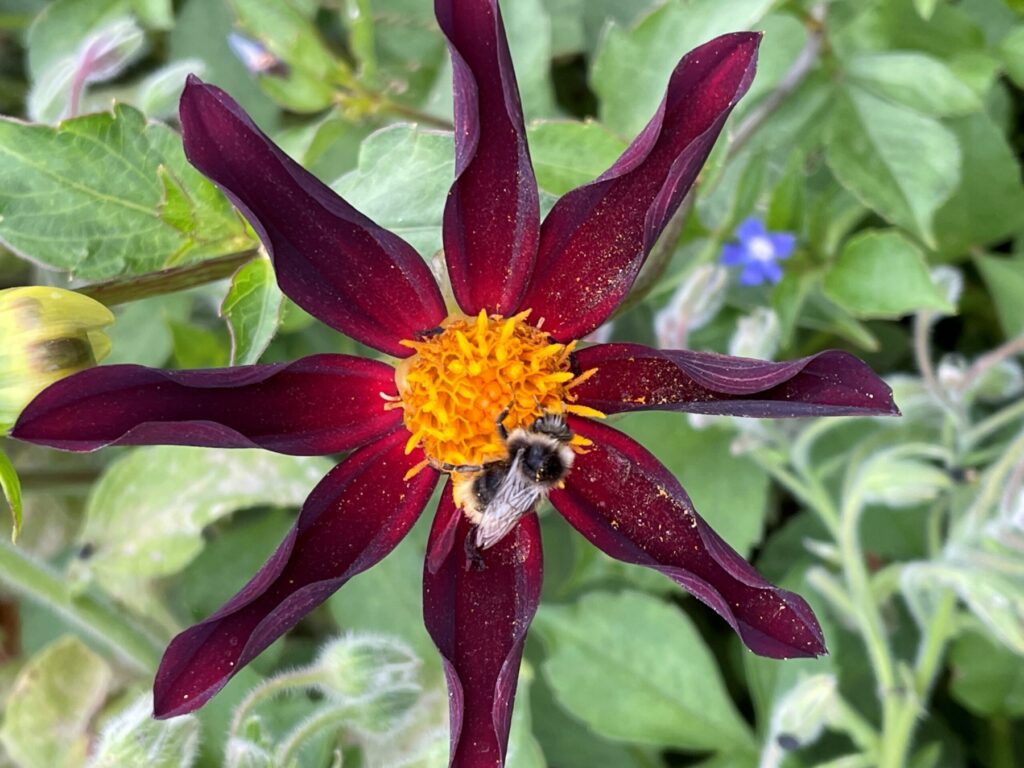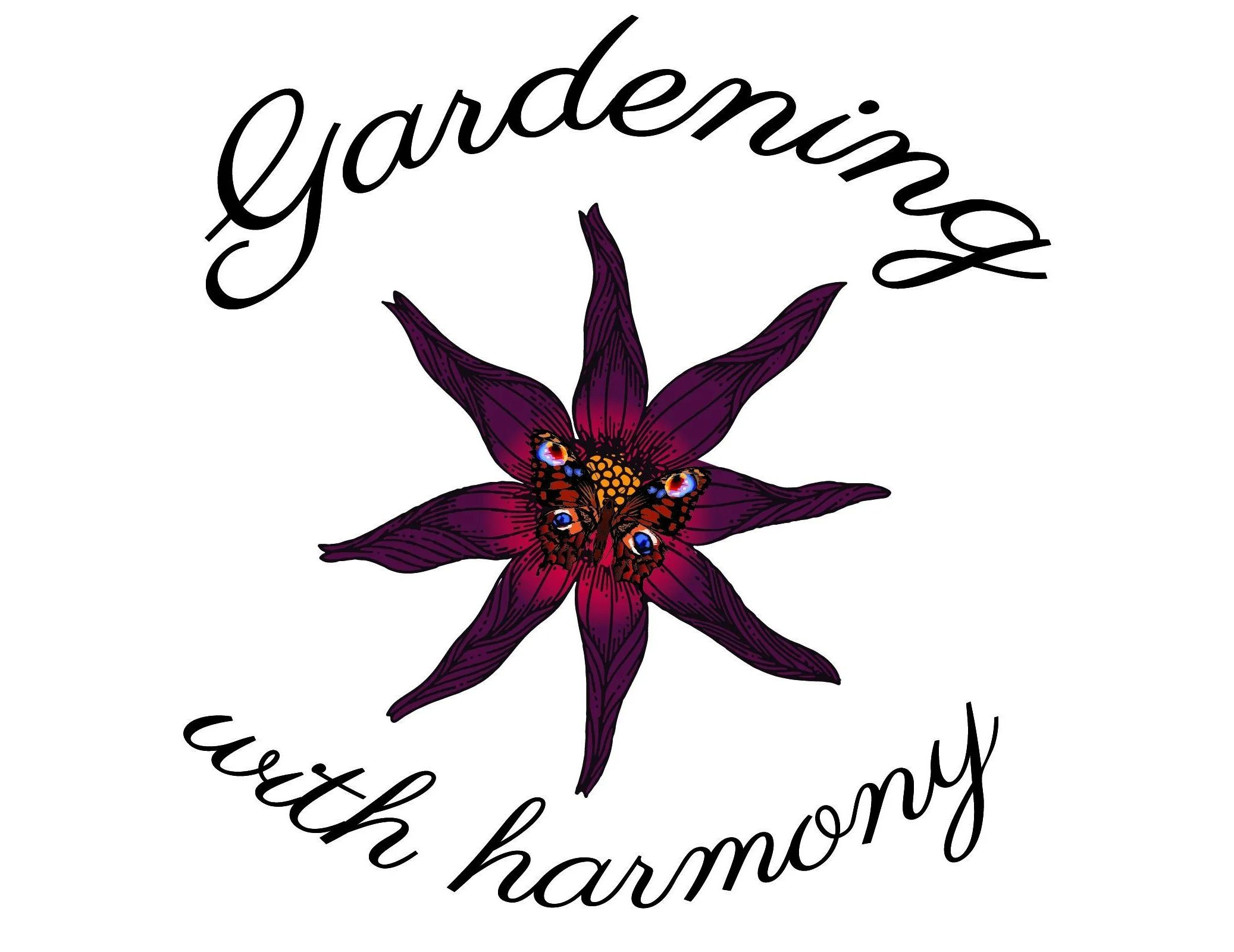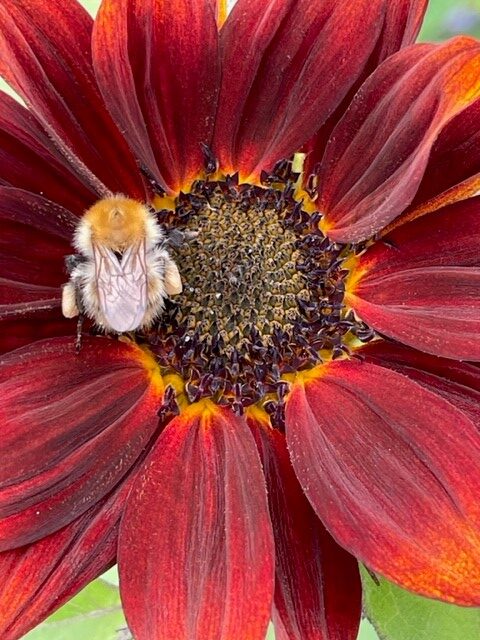My opening photo for this post is a beautiful sunflower (Velvet Queen) in my garden with a bee. Gardening for wellbeing for me always includes some sunflowers.
I always think that sunflowers are such a positive, happy flower to grow. Additionally, they are fabulous for wildlife. Providing nectar and pollen for our bees, butterflies and other pollinators, and later, seeds for our birds.
This post is inspired by World Mental Health Day, which is celebrated every year on October 10th.
The Mental Health Foundation gives advice that protecting our mental health is easier than we might think.
Firstly, they mention, we can all do it every day. Oh, that could involve gardening then I’m thinking!
Secondly, with simple activities that help us feel ok, we’re better able to cope with life. Goodness, that could be gardening too!
Also, it can be fun! – Well, that is most definitely gardening isn’t it. Fabulous fun, especially if you garden with chickens and cats as I do!
I honestly believe that gardening is a fantastic boon to wellbeing. And, I have my own evidence of this with my story which can be accessed here Wonderful powers of a flower
Additionally, the earlier posts featuring my dear friends, the Cosmos Queen, and The Chief Gardener, gives many examples of how gardening for wellbeing has helped to boost them too.
Gardening is also a fantastic way to connect with other people and cultivate friendships.
I have taken a few of the titles for tips from the Mental Health Foundation for this post, and here is the first one.
Get closer to nature

The first tip is to get closer to nature.
Gardening is an excellent way of connecting with the natural world and is so beneficial for both our physical and mental health.
I took part in the 30 Days Wild this year, The Wildlife Trusts’ annual nature challenge where we were asked to do one ‘wild’ thing a day every day throughout June.
All in all, a fabulous experience, and one I have continued in my garden every day since the 30 days ended. It is amazing to see how much wildlife we share our gardens and outdoor spaces with.
Some examples
One example is to watch the life in my wildlife ponds or the dragonflies and damselflies flitting around above the water.
Another example is watching the beautiful butterflies, the bees, and the hoverflies on all the flowers I have provided for nectar and pollen.
Or watching the sunrise or sunset, seeing how many birds you can see and hear. Also, watching the stag beetles flying around in the evening in June, or the bats on the wing.
Gardening is a great way to bring nature to us. Providing habitats, food and shelter brings nature in to share our spaces.
All we then have to do is find a place to sit quietly outside and focus on tuning in with nature. Occasionally my chickens stay quiet for a while and sit down too, and often the resident robin perches nearby.
You might like to check out the five posts (within blog posts), on my 30 days wild to see how much wildlife can often be seen in our gardens.
Plan things to look forward to

The next tip is to plan things to look forward to.
Making plans for things we enjoy can increase our sense of hope. This is so important for our mental health and wellbeing
I have chosen a photo of some of my tulips here. For me, there is something magical about planning for a colourful spring.
Additionally, winter is a time to take stock of what works in the garden and what could be even better.
Furthermore, there could be plant combinations that work so well, you would like to repeat them in some borders, other areas, or pots.
I also love choosing seeds for spring and planning where they will be transplanted after sowing and growing. Often in new borders, (more planning there then), or into pots that can be moved around.
Links can be found at the end of this post for where I purchase my seeds.
I find that planning for the spring and summer keeps me happier over a long and dreary winter. Plenty of measuring in the garden for new borders too.
The joy of a greenhouse

Additionally, if you have a greenhouse, as I do, growing winter crops is a fantastic way to keep gardening every day of the year. Gardening for wellbeing at its best.
Favolosa, my beautiful greenhouse can be seen in the photo above, at sunset. Time for my rescue girls to go to bed for the night and Pickle Pixie Pantaloon can be seen, striding past, on her way to the hen house for a snooze.
And striding back to talk about Favolosa, I usually grow kale, spinach, early peas, lupins, calendula, delphiniums, aquilegia, and sweet peas as a minimum over winter.
Naturally, it becomes a bit of a squeeze in February and March when the dahlia tubers are started in pots and I start sowing my cosmos, morning glory, zinnias, stocks, tomatoes……
Ok, plenty of planning to do then in my beautiful happy place called Favolosa!
Be kind & help create a better world

Next, the tip is to be kind and help create a better world. This could be creating a better world for wildlife, which also benefits us as well.
I boost my wellbeing by gardening for wildlife, creating a better world for nature in my garden. Primarily this involves sowing plenty of flower seeds for pollinators.
Additionally, having some wild spaces for wildlife to shelter, breed and feed is important to me. Clearly, it is of vital importance to the wildlife I share my garden with as well. I also have four wildlife ponds which are fantastic for wildlife. Some kindness comes in when I spot an insect which has fallen into a pond and needs a gentle hand to get back out and dry off.
Also, attracting wildlife is a jolly good reason for us to sit for a while and observe the bees, butterflies, hoverflies, dragonflies, frogs, birds, and other wildlife sharing our gardens with us. Such a boost to our wellbeing and mental health, knowing we have provided the flowers, plants, and habitats to help nature thrive.
And of course, this ties in nicely with the tip to get closer to nature above.
Wild Spaces
Butterfly Conservation is asking everyone to create more Wild Spaces if they can and I am keen to get involved.
So here are the requirements if you are interested. A Wild Space should be free from pesticides. Where compost is used in a Wild Space, it should be peat free. Wild Spaces should be permanent – the goal is about making lasting change.
Some example locations of Wild Spaces could be a garden, a balcony, a courtyard, some pots, allotments, and schools.
Leave a patch or strip of grass to grow long, as grass is the food for several butterflies that can live in gardens (including speckled wood, meadow brown and gatekeeper) Furthermore, this will also be a home for grasshoppers, some bees, ladybirds and other beetles.
More details can be found in the link below for Wild Spaces, if you would like to get involved.
https://butterfly-conservation.org/wild-spaces
What a gardening for wellbeing boost we can get, when helping wildlife to thrive.
Eat healthy food

The next tip they give is to eat healthy food.
Primarily, a balanced diet with plenty of vegetables and fruit is essential for good physical and mental health.
For this reason, it is fantastic if we can grow some of our own vegetables and fruit. Fruit and vegetables can be grown and nurtured by us and then we can enjoy many fresh, tasty and nutritious meals.
Clearly, nothing beats the flavour and nutrient-packed power of freshly-picked vegetables and fruit. More gardening for wellbeing, packed with tasty treats!
Additionally, it can save us money on food shopping and crucially, reduces our environmental impact.
Confirmation of the joys of growing our own vegetables and fruit can be found in a couple of my earlier posts featuring the Chief Gardener. You can check them out below. Great examples for gardening for wellbeing.
The Chief Gardener’s beautiful vegetables
The Chief Gardener grows a tasty fruit feast
Keep moving

The last tip I have chosen is keep moving.
Mowing a lawn, digging, raking, and even turning the compost are forms of aerobic exercise.
Also, using hand tools has as many benefits, keeping us moving and flexible.
In addition, gardening involves plenty of bending, lifting, pushing, and pulling, so a vast array of movements to clock up to keep us supple.
Also, trundling up and down with the watering can will soon rack up some steps. I have frequent trips to Favolosa, my greenhouse, and also some pots in the warm weather.
Even walking around the garden (without the watering can) keeps us active and there is always somewhere to head to in my garden, and more fun tasks to perform. Normally with some lovely helpful chickens and cats in attendance. Gardening for wellbeing is always boosted when my chickens are helping!
I think a daily stroll (or fifty strolls in my case), around the garden is one of the most enjoyable things to do. It allows for a peaceful moment to see what has grown, what is flowering, and what wildlife is enjoying your space.
The joy of gardening

Finally, I wanted to repeat some words in a message I received from my dear friend, the lovely Cosmos Queen. Previously added to my post The awesome power of the garden with her permission.
“I came in from watering my garden tonight and I turned in the doorway to look back at my garden. I thought to myself, I have done all this myself, with a lot of encouragement from the Dahlia Queen. For the first time since losing my husband I realised that I had a deep sense of wellbeing that had been missing up to now. And it was all down to you and gardening, so thank you honey”
What a lovely message and how heartwarming to see what gardening can bring to our lives. More fantastic gardening for wellbeing evidence.
We have cultivated a strong friendship through gardening and we share our many triumphs and the occasional disaster.
Furthermore , we have a jolly good laugh, and share our gardening plans for the future. More borders for both of us clearly!
Since, the Cosmos Queen has become another super fan of the dahlia, I have used two of my dahlia photos above and below.

Whenever I passed this beautiful dahlia, I stopped to gaze at the flowers. Although this dahlia is not ideal for pollinators, due to the ball shape, it was amazing to see how often some butterflies were resting on the blooms and warming themselves in the sun. Clearly, an ideal flower for a soft and attractive place to rest and soak up some rays.
In addition, as the blooms faded, the bees and butterflies were able to reach some nectar and pollen as the inner petals fell.
So, grow whatever you like to see and makes you happy, and nature will normally find a way to benefit too.
Seeds for the future
I have provided links below for purchasing seeds. I use all of them and have had great results with everything I have grown.
Primarily they are flower seeds that I sow, but I also grow tomatoes, chard, kale, courgettes, spinach, strawberries, and runner beans, to name a few plus some herbs.
I think that sowing seeds will always fill me with excitement. Getting my hands in the compost or soil, sowing the seeds and watching them germinate into the first shoots.
Likewise, pricking out the seedlings as they grow, potting on, and planting out is super exciting to me. Followed by seeing the flowers bloom or eating those ripe tomatoes is the best, a truly beautiful, and beneficial boon to wellbeing.
Here are the links for all types of seeds you could grow.
Amazon, all seeds https://amzn.to/3rtEwCp
Click here for Thompson and Morgan seed options.
And click here for Sarah Raven seed options
Gosh, I have just spotted some sweet peas called Purple Pimpernel from Thompson and Morgan. One for my list for sure, and the list is getting ever longer.
This blog is a participant in Amazon’s Associate’s Program, and affiliated with Sarah Raven and Thompson and Morgan. If you click on one of these links above, and make a purchase I may receive a commission, at no additional cost to you.
I hope you have enjoyed this post. I will finish with a quote from Gertrude Jekyll, a famous horticulturalist and garden designer.
“The love of gardening is a seed once sown that never dies”
To see all my updates as they happen, please enter your email address below and press the subscribe button.



2 responses to “Gardening for wellbeing, a beautiful beneficial boon”
Love this post. That red sunflower is amazing. Seeds for next year I think🤭
Thanks for the feedback. Pleased you love this post. The sunflowers are a beautiful colour, variety Velvet Queen, and I purchased from Amazon if this helps. Thanks again 🌸